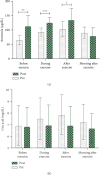Potential Biomarkers of Peripheral and Central Fatigue in High-Intensity Trained Athletes at High-Temperature: A Pilot Study with Momordica charantia (Bitter Melon)
- PMID: 32587872
- PMCID: PMC7298321
- DOI: 10.1155/2020/4768390
Potential Biomarkers of Peripheral and Central Fatigue in High-Intensity Trained Athletes at High-Temperature: A Pilot Study with Momordica charantia (Bitter Melon)
Abstract
Among potent dietary supplements, Momordica charantia, commonly called bitter melon, has various biological effects, such as antioxidant and anti-inflammatory effects, and improves energy metabolism and fatigue recovery. However, it is unknown whether Momordica charantia extract (MCE) induces antifatigue effects during exercise training in high-temperature environments. This study aimed at investigating the efficacy of MCE by examining 10 male tennis players consuming 100 mL MCE/dose (6 times a day over 4 weeks) during the summer training season. Peripheral (ammonia and uric acid) and central (serotonin, dopamine, and prolactin) fatigue parameters were measured before and after MCE consumption; before, during, and after exercise; and the next morning. After consuming MCE supplements, ammonia levels were higher during and after exercise and recovered the next morning, whereas uric acid levels did not change at any time point. Serotonin levels were lower during exercise. Dopamine levels were higher, especially during exercise. Prolactin levels were lower at all time points, especially during and after exercise. Although high-intensity training in a hot environment causes accumulation of fatigue-related metabolites, our results indicate that 4 weeks of MCE intake positively influenced fatigue parameters, suggesting that MCE can efficiently combat fatigue.
Copyright © 2020 Jae-Jun Kwak et al.
Conflict of interest statement
The authors declare no conflict of interest.
Figures


References
-
- Mielgo-Ayuso J., Calleja-Gonzalez J., Del Coso J., Urdampilleta A., León-Guereño P., Fernández-Lázaro D. Caffeine Supplementation and Physical Performance, Muscle Damage and Perception of Fatigue in Soccer Players: A Systematic Review. Nutrients. 2019;11(2) doi: 10.3390/nu11020440. - DOI - PMC - PubMed
MeSH terms
Substances
LinkOut - more resources
Full Text Sources
Medical

